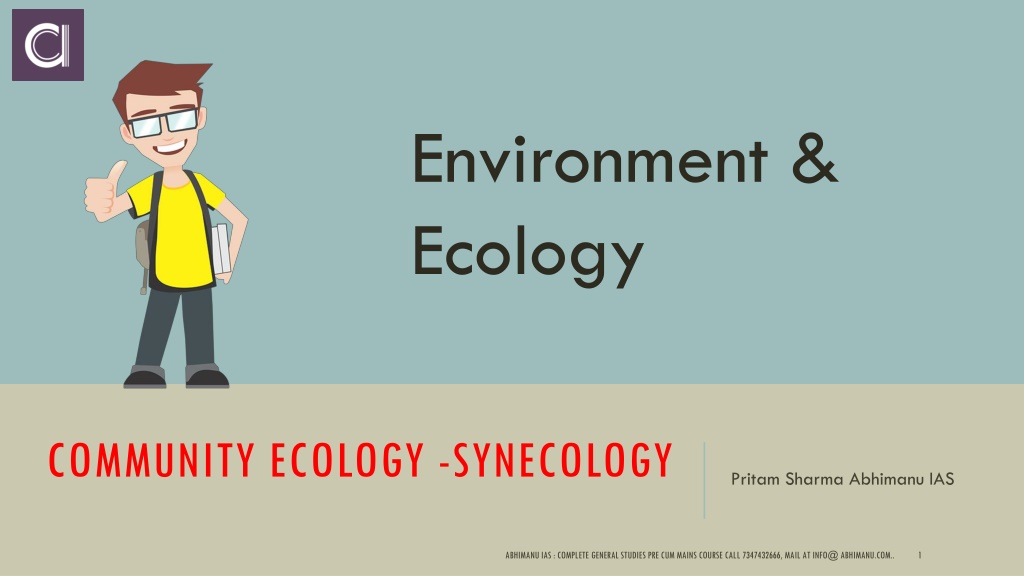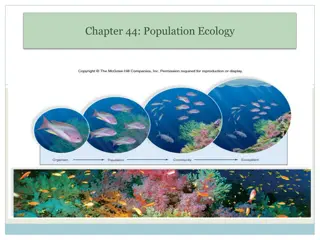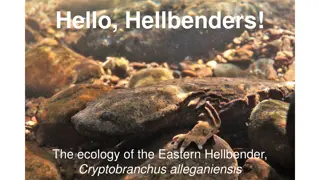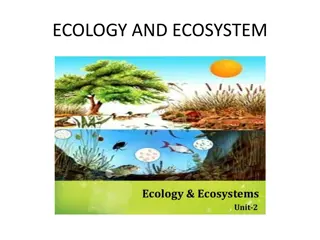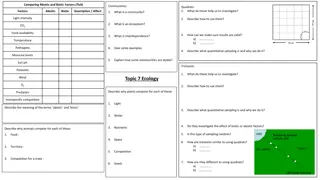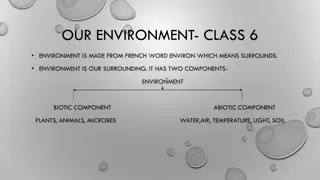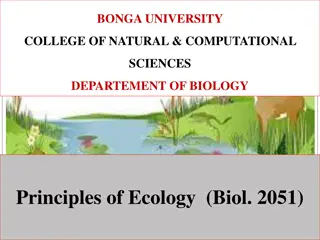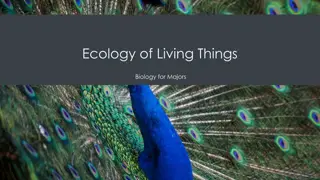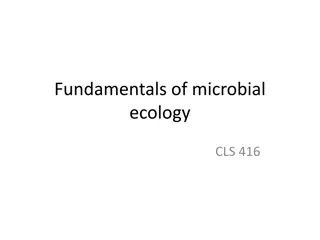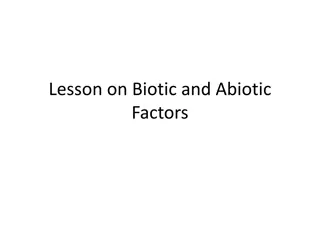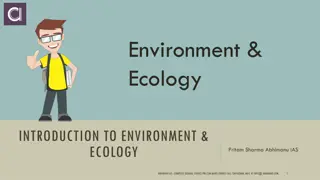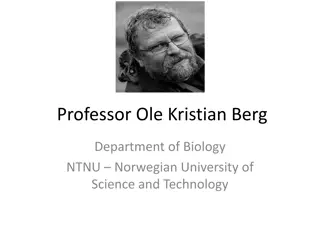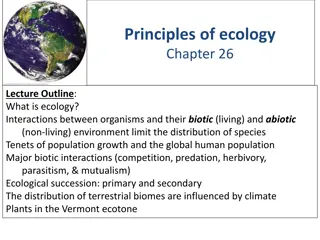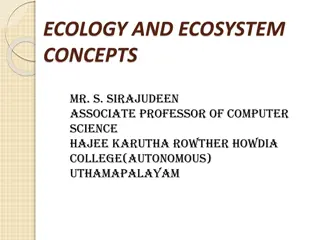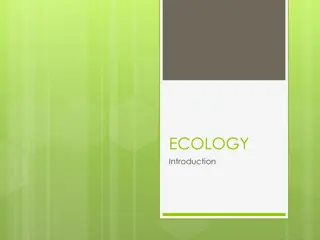Understanding Biotic Communities in Ecology
Biotic communities play a crucial role in ecology, representing interactions among different species sharing the same habitat. This interdependence is essential for the survival and balance of various organisms in nature. Each community has unique characteristics, such as species composition, reflecting the diversity and dynamics of life within it. Recognizing the significance of biotic communities helps us appreciate the interconnectedness of all living beings in an ecosystem.
Download Presentation

Please find below an Image/Link to download the presentation.
The content on the website is provided AS IS for your information and personal use only. It may not be sold, licensed, or shared on other websites without obtaining consent from the author. Download presentation by click this link. If you encounter any issues during the download, it is possible that the publisher has removed the file from their server.
E N D
Presentation Transcript
Abhipedia IAS Environment & Ecology COMMUNITY ECOLOGY -SYNECOLOGY Pritam Sharma Abhimanu IAS ABHIMANU IAS : COMPLETE GENERAL STUDIES PRE CUM MAINS COURSE CALL 7347432666, MAIL AT INFO@ ABHIMANU.COM.. 1
Abhipedia IAS WHAT IS A BIOTIC COMMUNITY? As we know that a community is the third level in the hierarchy of Biological organization and in ecology it has a precise meaning referring to a group of organisms living on the same habitat but belonging to the different species, interacting with each other. In short, a biotic community is an interaction among the organisms of two different populations living on the same territory. Why Biotic community? As we already know that no habitat in this nature contains the individuals of only one species. In fact, a population of a single species cannot survive by itself because there is always an interdependence of one form of life on another at least, for food; any species requires one more species on which it can feed. Even Plants cannot survive on their own, for they also require microbes to break down the organic matter and pollinators ABHIMANU IAS : COMPLETE GENERAL STUDIES PRE CUM MAINS COURSE CALL 7347432666, MAIL AT INFO@ ABHIMANU.COM.. 2
Abhipedia IAS for the sake of pollination to disperse their pollens onto different flowers. This simply means that the mother nature is an interconnected whole as the life of every organism is significantly influenced by that of all others around it. This was what a British Biologist of 19th century illustrated it so beautifully when he said that: Glory of Britain is due to her old maids as the healthy Britons are nourished by roasted beef: beef supplying cattle feed on grass: Grass is pollinated by bees: bee nests are destroyed by field rats: the number of rats depend upon the number of Cats. Since Cats are reared by old maids, the old maids thus determine the supply and availability of beef. ABHIMANU IAS : COMPLETE GENERAL STUDIES PRE CUM MAINS COURSE CALL 7347432666, MAIL AT INFO@ ABHIMANU.COM.. 3
Abhipedia IAS From the above illustration, we can thus conclude that in nature there is always an interdependence among the organisms in a given habitat such that a kind of living community (biotic community) comes into being. This natural association of the interdependent populations of different species inhabiting a common environment or habitat as a viable, self-contained unit is called, a biotic community, or biocoenosis. In short, in the simplest words, a biotic community may be considered as a multi-species population.
Abhipedia IAS CHARACTERISTICS OF A BIOTIC COMMUNITY In nature, each biotic community is known for its unique characteristics which differentiates it from other biotic communities. Some of these features may be discussed as below: 1. Species composition: Each biotic community has its distinct species of animals and plants which constitute the species composition of the particular community. For example, in a grassland, the species of animals may be herbivores such as Zebras, Giraffes, Deer etc, and the species of carnivores can be Lion, Tiger or Leopards etc. Among plants, it may be shrubs, herbs or grasses and no Trees. Similar is the case of an ocean where the species composition may be entirely different.
Abhipedia IAS 2. Dominant Species: In every biotic community, there would be some species which are dominant over the others on whose basis that community is named. For example, in a forest community the dominant species may be tall trees of a particular species. For example in a grassland, it is the grasses that are dominant over all other herbaceous plant species. However, the communities are also named after the environmental factor say, a desert or marine community. 3. Stratification: It refers to the vertical layering of vegetation in a community accompanied by an associated animal life. Similarly, in a Lake or other aquatic biotic community, we have surface and bottom dwellers depending upon the penetration of light through stratified layers of water. MPLETE GENERAL STUDIES PRE CUM MAINS COURSE CALL 7347432666, MAIL AT INFO@ ABHIMANU.COM.. 6
Abhipedia IAS 3. Key stone and Link species: In every biotic community, there are some species which are so important that they pose a profound impact on the abundance of other species in the community. For example, in a tropical rain forest, different species of fig tree a ct as a keystone species. Similarly, the Beavers in an aquatic ecosystem act as keystone species as they manipulate the aquatic environment by constructing dams and construct pools that act as a habitat for many other species. The significance of a key stone species can be explained with the help of the famous Rivet-Popper hypothesis. The Link species on other hand refer to those species in a biotic community that act as a link between a number of other species or play a vital role in the absorption of minerals like Mycorrhiza. Insects & Birds act as link species.
Abhipedia IAS 4. Ecotone and Edge effect: An ecotone is a transitional area between two or more communities. It contains the species from both the communities. It is always noted for the abundance of organisms or species. This phenomenon is referred to as Edge effect. The species living in the ecotone region are referred to as the edge species. For example, a grassland and pond meeting together in a region is called as ecotone having species living in this area from both the communities.
Abhipedia IAS INTERACTIONS IN A BIOTIC COMMUNITY Interactions in a Biotic community can broadly be beneficial, detrimental or neutral (neither harm nor benefit) to one of the species or both. To understand them in a better way, let s assign a + sign for beneficial interaction, - sign for detrimental and 0 for neutral interaction and then try to look at all the possible outcomes of interspecific interactions. Accordingly, we shall observe that these interactions may manifest themselves in some of the following forms such as Mutualism, Commensalism, Parasitism, Predation, Competition and Amensalism etc. Lets discuss each of these interactions and seek to know how they actually operate in Nature . ABHIMANU IAS : COMPLETE GENERAL STUDIES PRE CUM MAINS COURSE CALL 7347432666, MAIL AT INFO@ ABHIMANU.COM.. 9
Abhipedia IAS 1. 1.Mutualism: This interaction confers benefits on both the interacting species. Lichens represent an intimate mutualistic relationship between a fungus and photosynthesizing algae or cyanbacteria. Similarly, the mycorrhizae are associations between fungi and the roots of higher plants. The fungi help the plant in the absorption of essential nutrients from the soil while the plant in turn provides the fungi with energy-yielding carbohydrates. The most spectacular and evolutionarily fascinating examples of mutualism are found in plant-animal relationships. Plants need the help of animals for pollinating their flowers and dispersing their seeds. Animals obviously have to be paid fees or so called allowance for the services that plants expect from them i.e. dispersal of its pollen grains. Plants offer rewards or fees in the form of pollen and nectar for pollinators and juicy and nutritious fruits for seed dispersers.
Abhipedia IAS 2. Commensalism: This is an interaction in which one species benefits and the other is neither harmed nor benefited. Say for example, an orchid growing as an epiphyte on a mango branch, and barnacles growing on the back of a whale, benefit while neither the mango tree nor the whale derives any apparent benefit from the growth of such second species. The cattle egret and grazing cattle browsing in close association, a sight we are most likely to catch if we were to live in a farmed rural area, is a classic example of commensalism. The egrets always forage close to where the cattle are grazing because the cattle, as they move, stir up and flush out from the vegetation insects that otherwise might be difficult for the egrets to find and catch. Another common example is Clown fish and Sea Anemone. ABHIMANU IAS : COMPLETE GENERAL STUDIES PRE CUM MAINS COURSE CALL 7347432666, MAIL AT INFO@ ABHIMANU.COM.. 11
Abhipedia IAS 3. Predation: Besides acting as conduits for energy transfer across trophic levels, predators ecologically play other important roles as well. They keep prey populations under control. But for predators, prey species could achieve very high population densities and cause ecosystem instability. When certain exotic species are introduced into a geographical area, they become invasive and start spreading fast because the invaded land does not have its natural predators. The prickly pear cactus introduced into Australia in the early 1920s caused havoc by spreading rapidly into millions of hectares of rangeland. Finally, the invasive cactus was brought under control only after a cactus- feeding predator (a moth) from its natural habitat was introduced into the country. Biological control methods adopted in agricultural pest control are based on the ability of the predator to regulate prey population.
Abhipedia IAS 4. Competition: It is generally believed that competition occurs when closely related species compete for the same resources that are limiting, but this is not entirely true. Firstly, totally unrelated species could also compete for the same resources. For instance, in some shallow South American lakes visiting flamingoes and resident fishes compete for their common food, the zooplankton in the lake. Secondly, resources need not be limiting for competition to occur; in interference competition, the feeding efficiency of one species might be reduced due to the interfering and inhibitory presence of the other species, even if resources (food and space) are abundant. ABHIMANU IAS : COMPLETE GENERAL STUDIES PRE CUM MAINS COURSE CALL 7347432666, MAIL AT INFO@ ABHIMANU.COM.. 13
Abhipedia IAS 5. Parasitism: It is an interaction between two species what we call as HOST and PARASITE. To survive, the parasite develops certain adaptations such as: the loss of unnecessary sense organs, presence of adhesive organs or suckers to cling on to the host, loss of digestive system and high reproductive capacity. The life cycles of parasites are often complex, involving one or two intermediate hosts or vectors to facilitate parasitisation of its primary host. For example, human liver fluke (a trematode parasite) depends on two intermediate hosts (a snail and a fish) to complete its life cycle. The malarial parasite called as plasmodium, on the other hand, needs a vector (female Anopheles mosquito) to spread to other hosts.
Abhipedia IAS Majority of the parasites harm the host; they may reduce the survival, growth and reproduction of the host and reduce its population density. They might render the host more vulnerable to predation by making it physically weak. Ecologically speaking, the parasites can be of two types called as Ectoparasites and Endoparasites. Parasites that feed on the external surface of the host organism are called ectoparasites. The most familiar example of this group is the lice on humans and ticks on dogs. The female mosquito is not considered a parasite, although it needs our blood for reproduction because, it does not live in permanent association with the human host all the time which is an essential criterion for being a parasite. ABHIMANU IAS : COMPLETE GENERAL STUDIES PRE CUM MAINS COURSE CALL 7347432666, MAIL AT INFO@ ABHIMANU.COM.. 15
Abhipedia IAS In contrast, endoparasites are those that live inside the host body at different sites (liver, kidney, lungs, red blood cells, etc.). Brood Parasitism: What is it ? In some birds, a very fascinating example of parasitism can be seen what we call as brood Parasitism. Here, the parasitic bird lays its eggs in the nest of its host and lets the host incubate them. In nature, it is seen live in case of cuckoo laying her eggs in Crow s nest. During the course of evolution, the eggs of the parasitic bird have evolved to resemble the host s egg in size and color to reduce the chances of the host bird detecting the foreign eggs and ejecting them from the nest. This can be easily observed in nature by watching the movements of the cuckoo (koel) and the crow in our neighborhood park especially during breeding season .
Abhipedia IAS Thank You ABHIMANU IAS : COMPLETE GENERAL STUDIES PRE CUM MAINS COURSE CALL 7347432666, MAIL AT INFO@ ABHIMANU.COM.. 17
